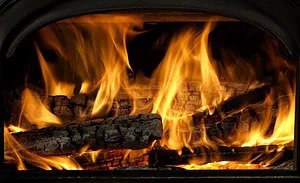The use of fire for warmth may date back to the Stone Age, but the principles of getting a wood fire started haven’t changed a bit. Untold millions have tried and failed to get a nice wood-fueled blaze going in their fireplace. The primitive task actually can be daunting, and getting just the kind of fire you want requires some know-how. If you understand the elements required for starting a fire, however, you’re well on your way. Details follow about bringing together the three components of fire-starting, which are: Fuel, air, and heat.
Fuel
The only types of fuel that should be used in your fireplace are tinder, kindling, and logs. Do not use yard debris or colored paper in your fireplace because it’s unsafe to do so. All wood that is used should be dry or seasoned. When unseasoned wood is burned, the moisture inside uses the majority of the fire’s energy; and an increased amount of flammable, tar-like creosote is deposited in the chimney flue lining from green firewood.
Tinder.
Tinder materials are easily ignited. Out in nature, milkweed fluff, pine needles, and wood shavings are great sources of tinder. To ignite the fire in your fireplace, dryer lint can be used but actually may not be the best choice, since the lint can contain synthetic materials. Newspaper, pencil shavings, moss, and twigs also make for good tinder. Only use sticks and twigs for tinder and kindling if it snaps and breaks because if it bends, it contains too much moisture.
Kindling.
The second phase of fire-building is when the kindling catches fire, creating more substantial flames. Sticks, small branches, and logs split into small sections serve well as kindling.
Logs.
There are two different types of wood: Softwoods and hardwoods. The logs are the fire’s fuelwood. If you want a fire that burns hot and quickly and does not leave lingering hot coals, burn softwoods. For long-burning firewood that produces lasting warmth from hot coals, choose hardwoods. Softwoods are the best sources of kindling since they ignite quickly and produce a good blaze.
Air
Air is the second necessary component to get a fire roaring in your top-rated, stunning wood fireplace. Producing a sufficient draft can be hindered for numerous reasons. There may be too many ashes beneath the grate. Sometimes a fire doesn’t get needed air because the home has negative air pressure, caused by being too tightly sealed. Opening a window in the home can usually provide a temporary solution if negative air pressure is causing the lack of air. If the chimney isn’t properly maintained, the draft may be hindered due to various potential obstructions.
Heat
The heat component of fire is what the cavemen had the most trouble with. Today, we have the benefit of matches and lighters. It is extremely dangerous to use liquid accelerants in your fireplace; it should never be done. The most recommended is to light your tinder and kindling with a long match.
Contact one of our member stores for chimney and fireplace maintenance and to ensure that it’s safe to develop or hone your fire-starting skills in your fireplace.

